Above: Cohoes Falls on the Mohawk River between Cohoes and Waterford, New York. Downriver from Ossernenon, the place of martyrdom of Ss. René Goupil, Isaac Jogues, and Jean de Lalande. Public domain.
“Laetatus sum eo quod dixerint mihi in domum Domini ibimus – I rejoiced at the things that were said to me: We shall go into the house of the Lord…” (Ps 121:1, DRB) So, on an autumn Thursday afternoon last year, I drove up a familiar hill off of NY Route 5S and wound up at the Coliseum Church at Ossernenon (Auriesville, NY). There in the parking area, I grabbed my gear, secured my car, and boarded a shuttle with other pilgrims. We were headed to Lac du Saint Sacrement (Lake George), the stepping off point of the 27th Annual Pilgrimage for Restoration, about an hour and a half drive away.
The chance discovery of a social media post last summer had once again gotten me thinking about the Pilgrimage for Restoration. Years ago, I had the opportunity to attend part of this march from the Lake of the Blessed Sacrament (so named by St. Isaac Jogues) to the Shrine of Our Lady of Martyrs – the site of his martyrdom and that of his companions, St. René Goupil and St. Jean deLalande. This time, I would be able to go on pilgrimage from start to finish. I applied to serve with the Company of Saint René Goupil, the group that sees to the medical needs and other material concerns of those on the Way, and I was so excited to find out that I had been accepted!
Enthusiastic teens, their parents, and I made introductions on the bench seats of our shuttle van. The memories of my many previous visits to the Shrine of Our Lady of Martyrs flashed through my mind. Highway exit signs and mile markers flashed past my window.
There was lots of activity going on at the state camp ground when the shuttle pulled in. Pilgrims were unloading bags from vehicles, setting up their tents, signing in with pilgrimage staff, getting ready for holy Mass. Young kids, teenagers, young adults, old adults, men and women religious in habits, cassocked priests, a bishop. Several of us went up to the statue of St. Isaac Jogues where Mass was soon to be offered. After Mass, the Company of Saint René Goupil met for its first briefing.
I had mismanaged my arrangements for Thursday night and, rather than see me sleep outside in the cold or quite possibly have to go home, other members of the Company shared their accommodations with me. As activity wound down late that evening, I rechecked my equipment and restocked my BLS medical bag. I hoped that most of what I’d packed would remain right where it was, unnecessary and unused.
We stowed our larger bags in the transport vehicles shortly after 0600 on Friday, and made our way across the highway and along Lac du Saint Sacrement just before sunrise, an ember day this year.
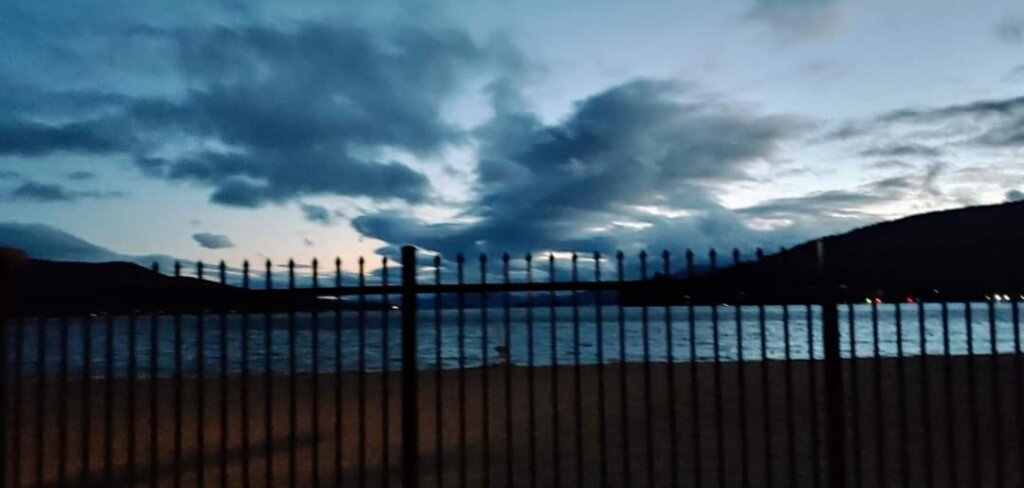
Everything was set up for holy Mass at St. Isaac’s statue, and we began to arrange ourselves by groups on the grass. Bishop Coffey took his place in choir. The schola began to sing. Altar boys processed. Priest and attendant Deacon and Subdeacon approached the altar beneath the tent, and into the frigid early morning air the first quiet words accompanying the Sacrifice, cloaked in the schola’s chant, were uttered. “In Nomine Patris et Filii et Spiritus Sancti. Amen. Introibo ad altare Dei…”
A simple breakfast followed according to each one’s conscience and constitution. It was, after all, a Friday and an ember day and the first day of an arduous walking pilgrimage. In the final days of the Lent of St. Michael. Pilgrims shared packets of instant coffee among themselves and approached large pots from which the cooks portioned hot water into whatever the individual pilgrim had brought or was able to find.
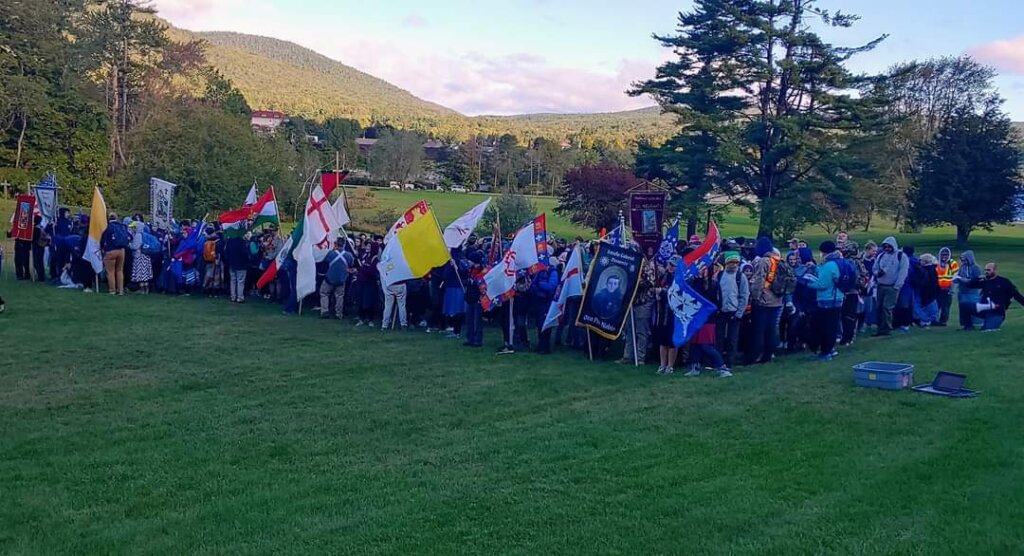 Announcements and the formation of the fifteen brigades came next. Vexillum after vexillum took its place on the field, and the pre-formed groups of pilgrims began to fall in behind them. St. Michael. St. Joseph. St. Stephen the Proto-Martyr. St. Lawrence. St. Stephen of Hungary. St. Joan of Arc. St. Isaac Jogues. Pilgrims of all earthly stations and the chaplains took their places behind these standards and others like them. We were exhorted to form the individual intentions we would be taking on pilgrimage.
Announcements and the formation of the fifteen brigades came next. Vexillum after vexillum took its place on the field, and the pre-formed groups of pilgrims began to fall in behind them. St. Michael. St. Joseph. St. Stephen the Proto-Martyr. St. Lawrence. St. Stephen of Hungary. St. Joan of Arc. St. Isaac Jogues. Pilgrims of all earthly stations and the chaplains took their places behind these standards and others like them. We were exhorted to form the individual intentions we would be taking on pilgrimage.
The priest of God began the prayer to consecrate the vexilla. “…May the holy archangel, Raphael lead us out, and may he get us safely home,” he invoked the name of the patron saint of travelers toward the end of his prayer. Each raising its distinctive battle cry, one brigade after another took up its vexillum and its cross and left the field for the pilgrim road. So began this poor pilgrim’s way with his brethren from Lac du Saint Sacrement to Ossernenon, sometimes called the Land of Crosses.
The Holy Family Brigade – composed of moms and dads and toddlers and babies in their strollers – accompanied their fellows for about a mile’s distance out of camp. The drivers of empty shuttle vehicles looked over the singing pilgrims, prepared to pick up the weary. My teammates and I scanned the column from our seats in the medical vehicle. The cooks preceded everyone to the rest stops and to the next camp, and vans carrying our overnight gear went with them. Two trucks pulled trailers of portable toilets and stopped beside the road at regular intervals.
Young ladies – the Water Lilies, they were called – stood along the route with water and songs to encourage and support hundreds of penitents as they went their way carrying their intentions and offering their sacrifices to the Lord. Young men in reflective vests and fluorescent batons – the Mighty Safeties – sprinted past everyone on a parallel path, en route to intersections where they would facilitate the safe crossings of the several hundred pilgrims. Now and again, one or more of us would get out of the medical vehicle and walk. At other times, we’d pull off to the side of the road to tend to a blister or to a strain. Priests in their violet stoles were embedded throughout the column. The Bishop, too.
More blisters and more strains needed attention by the time we all stopped for a break. Preventative care for some and treatment for open wounds in the case of others, ace bandage wraps and ice and elevation for still more. Hydrate, hydrate, hydrate! Then it was time to press on.
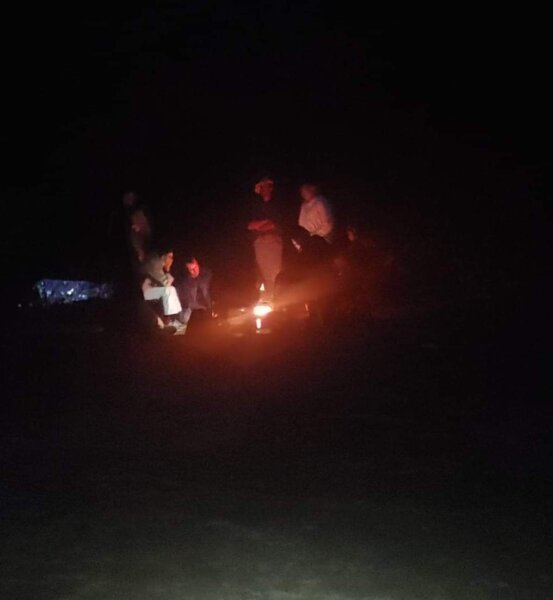 The Holy Family Brigade merged into the column for the final mile of the day and brought us into camp, where simple fair awaited simple, hungry folk. Our overnight bags were already arranged on tarps where pilgrims could come to claim them. We set up medical treatment stations in convenient locations for those in need who were able to come to us, and we went out to the tents of those who were not. The camp eventually settled down for a happy and well deserved rest, and voices could be heard near small fires singing the hours at their proper times.
The Holy Family Brigade merged into the column for the final mile of the day and brought us into camp, where simple fair awaited simple, hungry folk. Our overnight bags were already arranged on tarps where pilgrims could come to claim them. We set up medical treatment stations in convenient locations for those in need who were able to come to us, and we went out to the tents of those who were not. The camp eventually settled down for a happy and well deserved rest, and voices could be heard near small fires singing the hours at their proper times.
Saturday, another ember day within the Lent of St. Michael, began much like the day before. Bags were brought out and the hours could be heard before the pilgrims chanting them could be seen. Pots for boiling water were set up. The place and furnishings for holy Mass were arranged. Some of the priests prepared to hear confessions in remote spots. The pilgrims assembled, the schola began, the procession went forward, the Bishop in choir. This Pilgrimage gave me my first opportunity to experience the Masses of Embertide with all its lessons.
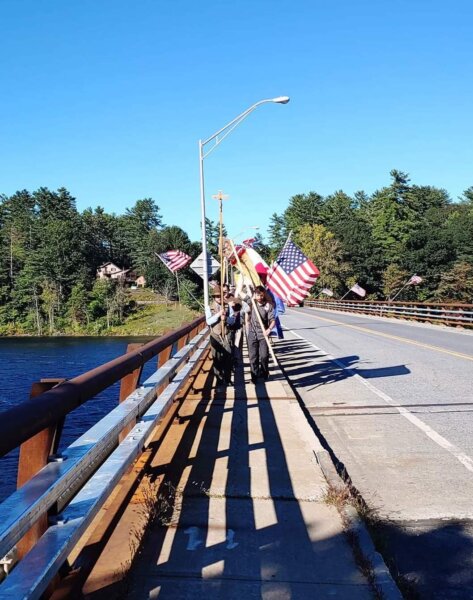
As the pilgrims’ common Mass for Ember Saturday continued, I thought I heard an altar bell some distance away sound the time for the Sanctus. Yet, it wasn’t time for the Sanctus at our Mass. I heard it again a few minutes later, off in another direction, and then I detected the unmistakable sound of a Byzantine thurible. Sacrifice was being offered “again and again” in different spots all around us in the hour before we were due to break camp! The pilgrims’ breath was visible and rose into the cold morning air with the incense.
It was reiterated many times that, no matter our role or whether we were walking or driving or riding, we were all on pilgrimage together. That said, several of us wanted to do more walking on Saturday than we had on Friday. All along the column, brigade by brigade, there was preaching and teaching by the chaplains and by the brothers and the smiling religious sisters. Priests were available for confessions. Our Lady’s Rosary was recited and chanted. Songs were sung. I tried to join the march far enough ahead in the column so that, as I fell back through the brigades, I would always be relatively close to the medical vehicle as it kept up with us, in case we had a patient. No pilgrim of any age or strength was left behind. No one could keep up with the Safeties though, as they sprinted along the line of march in their reflective vests!
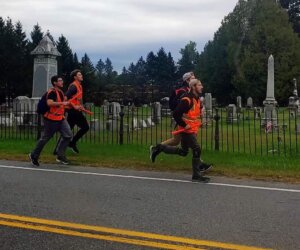
“Non nobis Domine! non nobis Domine…,” the cry went up from one part of the line. “Magnificat! Magnificat anima Mea! Laudate! Laudate Domino…,” came the song from another.
A lightheartedness spread over the Saturday night encampment. Two days’ walking behind us, there was still one day ahead… but there was only one day ahead! We visited several more patients in their tents that night, all of them in good cheer regardless of each one’s chief complaints. The cooks pulled out all the stops to prepare tasty, hearty food for a Pilgrim People on the move. Brigade members put on a talent night, and the sisters stole the proverbial show. Slowly, the laughter and the conversation died down, and the hours could be heard again near the fires.
Sunday began just like the previous two days, except that the common Mass would be offered at the Coliseum Church when the Pilgrims arrived at Ossernenon later that afternoon. As we checked on patients from the previous evening and provided preventative care for others, the bags were prepped for transport, nourishment was consumed by some in haste, and we all prepared to move. The altar bells of several Missae Privatae and the Byzantine thurible compelled pilgrim souls forward to the Land of Crosses – where we each already had arrived in our longing imaginations.
There were more songs, more prayers, more preaching, more teaching as we went on the Way. Rest stops gave us opportunities to check on injured pilgrims and treat emergent issues. The Water Lilies continued to provide water and keep up morale. I started looking for an opportunity to confess.
“Look!,” someone called out. “There it is!”
I turned my head and searched the distant hills to discover what he was pointing to as the column marched across a narrow stretch of the Mighty Hudson.
“Levavi oculos meos in montes, unde veniet auxilium mihi… – I have lifted up my eyes to the mountains, from whence help shall come to me…” (Ps 120:1 DRB) We still had a ways to go. It seemed like those who had been nursing wounds and other issues overnight were finding new strength. Not a neo-gnostic strength for a neo-pelagian effort; definitely something “other.”
The singing, praying, preaching, teaching intensified. At some point, the hills seemed steeper and came more frequently. It didn’t matter. It began to rain. It didn’t matter. On and on we went.
Do I need to confess? Should I confess? Can I wait till we arrive at the Shrine to confess? The enemy obviously didn’t want me to go to confession. “I didn’t begin this for your sake, and I will not stop because you object,” I remembered St. Ignatius quoting one of the Church Fathers on the subject of temptation. So, I approached the next priest I saw.
At last the Holy Family joined in the march, and the brigades passed the statues on the walls outside the Shrine! The light rain was steady now. It didn’t matter.
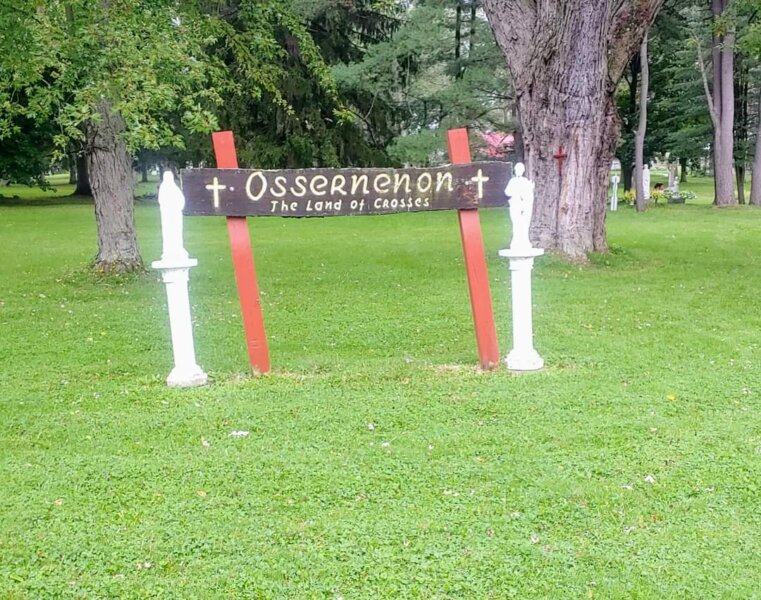
“…Stantes erant pedes nostri in atriis tuis Hierusalem – Our feet were standing in thy courts, O Jerusalem.” (Ps 121:2, DRB) Up a paved path the column advanced, the vexillum and cross before each brigade, to the Coliseum Church.
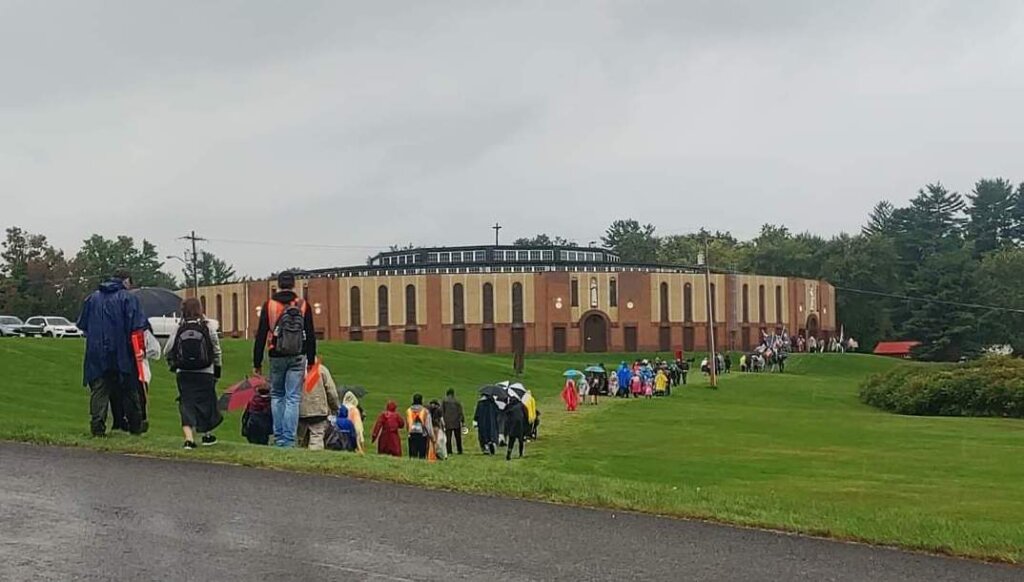
Within, the life sized stone images of roughly two hundred years-worth of sainted Jesuit fighting men stood at post along the wall. Loyola and Xavier. Gonzaga, Kostka and Berchmans. Canisius. Rodriguez and Claver. All the way around the perimeter of the structure they kept the watch, at the center of which building – at the distant end of the sloping aisles of bare wooden pews and kneelers – were four altars dedicated one each to the Martyrs of Ossernenon and to St. Kateri Tekakwitha, born of their blood. A sanctuary lamp flickered before one of the altars. The pilgrims had found the “Other” for Whom we’d come. There was a high altar in the center and above the other altars. Upon columns were crosses, beneath which was writ in blood red letters the Holy Name of the One who lived in the tabernacle.
Each brigade took its place on the benches, and the holy Mass of SS. Isaac Jogues, Jean de Brebeuf and Their Companions began.

The Oblation complete with the priest’s Communion, each Brigade in its turn was admitted to the altar rail. Mass over, each pilgrim was called forward to venerate the relics of the Jesuit Martyrs of North America, to encounter those heroes, those Athletes of God as some of the old prayer books call them.
As we all left the Coliseum Church and reassembled in formation outside, I thought a bit about the parts of the shrine that I wouldn’t be visiting that day.
Outdoor Stations of the Cross wound their way uphill along a certain path, at the end of which was a chapel. Beyond that and below as the pilgrim looked through the chapel window were row upon row of uniform headstones, beneath which slept Loyola’s band of brothers safely back in quarters from duty posts throughout the nineteenth and twentieth century New York Province. I had been a student of several of those more recently interred.
The Ravine. Along with the Hill of Torture on the Shrine Grounds and the Coliseum previously considered, that is a most important place when we’re talking about Ossernenon/Auriesville. It’s the very earth upon which Brother René Goupil spilt his blood for Christ. It was beneath the waters that run through the Ravine that Father Jogues submerged his Companion’s remains and later interred them in the ground nearby.
There on the grounds of Our Lady’s Shrine, on the same field upon which the Martyrs’ battle had been waged, at the culmination of the 27th Annual Pilgrimage for Restoration, Christ, His Bride, and all of Her children were represented before the Father. Our Lord Jesus Christ in His Real Presence. The Church Triumphant in the Martyrs, palms in hand, along with their brothers in Religion and all the patrons of our brigades. The Church Suffering, their bodies waiting in the graves of that cemetery. The Church Militant in battle array behind our vexilla, behind the Holy Cross. We were all there. So were you and yours, dear Reader, in the intentions we had formed before the first pilgrim took the first step onto the road.
As another confrere of the Martyrs insisted some sixty-two years before St. René Goupil fell at Ossernenon, we look in the mirror and then out to where we are sent and repeat:
“So the Faith was planted; so it must be restored.” (St. Edmund Campion, Campion’s Brag, 1580)
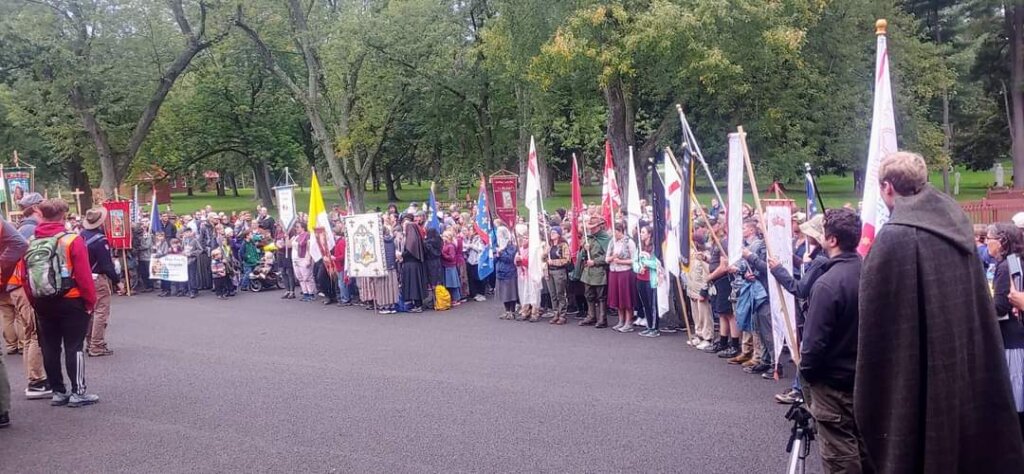
Editor’s note: the 28th annual Pilgrimage for Restoration takes place this year September 29 to October 1st


